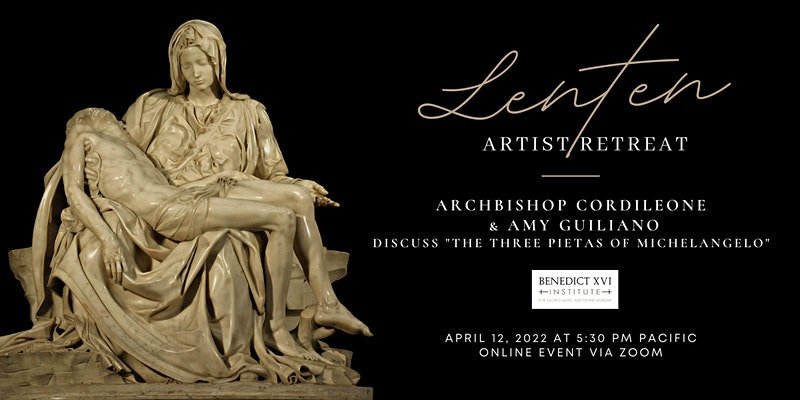Friday Links, April 8, 2022
Friday of the Fifth Week of Lent, the Friday Before Good Friday
+ Two Retreats for Artists:
One retreat in book form by the future Pope Karol Wojtyla, and
One retreat for Lent via ZOOM via the Benedict XVI Institute, contemplating Michelangelo’s Three Pietas.
+ Donatello Sculpture Exhibit Asks: Is Donatello Actually the Best Sculptor Ever and Father of the Renaissance?
+ Can a Writer Create a Fictional Saint? (Podcast: Thomas Mirus Asks Joshua Hren).
+ Twenty-first Century Pointilist Art by a Catholic Illustrator.
John Paul II's Retreat for Artists - Christopher West | Catholic Culture Podcast #130
In God Is Beauty: A Retreat on the Gospel and Art In Holy Week of 1962, you can follow a translation into English of five lessons that Bishop Karol Wojtyla, the future John Paul II, gave in a retreat to a group of Polish artists—along with commentary. Christopher West joins Thomas Mirus in the above-linked Catholic Culture podcast to discuss the retreat.
“The goal of art is to make visible through color through form and shape and through sound with music in architecture and in words such as poetry and literature to make communicable the incommunicable, meaning God.”—Christopher West
You can purchase the paperback at the TOB Institute store for 20% off the cover price (no limit) here. Use code: CULTURE.
A Lenten Retreat for Artists and Art Lovers
April 12 at 5:30 pm Pacific/8:30 pm Eastern
You can register here to join San Francisco Archbishop Salvatore Cordileone, Benedict XVI Institute senior fellow Amy Guiliano, St. Patrick Seminary's academic dean Dr. Anthony Lilles, and sacred music scholar and educator Dr. Jennifer Donelson-Nowicka at this Zoom event contemplating the three Pietas sculpted by Michelangelo.
The event—sponsored by the Benedict XVI Institute of Sacred Music and Divine Liturgy—is inspired by an exhibit on display at the Opera del Duomo in Florence from February 24 to August 1: “The Three Pietàs of Michelangelo: No one thinks of how much blood it costs.”
Video walkthrough of The Three Pietàs of Michelangelo exhibition at the Opera del Duomo Museum in Florence. For the first time, the three Pietàs are on display together, although by necessity the Vatican Pieta is a reproduction.
A Once-in-a-Lifetime Donatello Show Argues That Sculpture, Not Painting, Was the Ultimate Renaissance Art Form
From 19 March to 31 July 2022, the Palazzo Strozzi Foundation and the Bargello Museums present Donatello, the Renaissance.”
“The Renaissance was the triumph of sculpture,” the show’s curator Francesco Caglioti says. “And Donatello was a father of the Renaissance.”
If you are able to attend this show, while you are in Florence, you can also visit Museo dell’Opera del Duomo and see my favorite Donatello sculpture, which is not in the show. For understanding the contrast between what Donatello achieved in this wooden statue of the emaciated haggard penitent Mary Magdalene and the more-usual voluptuous depictions of the saint, this is a great article:
”Donatello’s Penitent Magdalene - A Wooden Masterpiece In Renaissance Florence.”
Mary Magdalene (from 1453 until 1455). Wooden sculpture originally polychromed and gilded. By Donatello, in the Sala della Maddalena in the Museo dell'Opera del Duomo.
Can a novelist depict a saint? (clip)
The above-linked clip is from a longer Catholic Culture Podcast, in which Thomas Mirus interviews Joshua Hren about Hren’s book, How to Read and Write as a Catholic. If you have more time, you can watch the full episode here:
Can a Novelist "Create" a Saint? - Joshua Hren | Catholic Culture Podcast #113
Pointilist Catholic Illustrator Quentin Leduc
Father Michael Rennier, Dappled Things contributor and web editor recommends the above-linked post from Shawn Tribe at Liturgical Arts Journal. Rosemary Callenburg, DT associate editor, Likes the idea.
"Today I wanted to share the work of Quentin Leduc, a young illustrator who practices his craft using the pointillist technique. Pointillism, for those not familiar, is the practice of using small points or dots, sometimes in different colours, other times simply in different densities and patterns, to create the visual illusion of a unified whole -- one might consider here how a mosaicist can use different small stones and gems to create something similar. For those interested in art history, one might recognize this as the technique used by the 19th century French artist Georges Seurat.
"In the case of Quentin Leduc, after studying art at the Saint-Luc Institute in Belgium, he started as a graphic designer and illustrator. He converted to Catholicism at the age of 21 and after studying Christian art for six years, he decided to make it his profession, creating various symbolic and iconographic Christian models in the gothic period style."
Pointillist images by Quentin LeDuc for sale at https://quentinleduc.bigcartel.com/products





